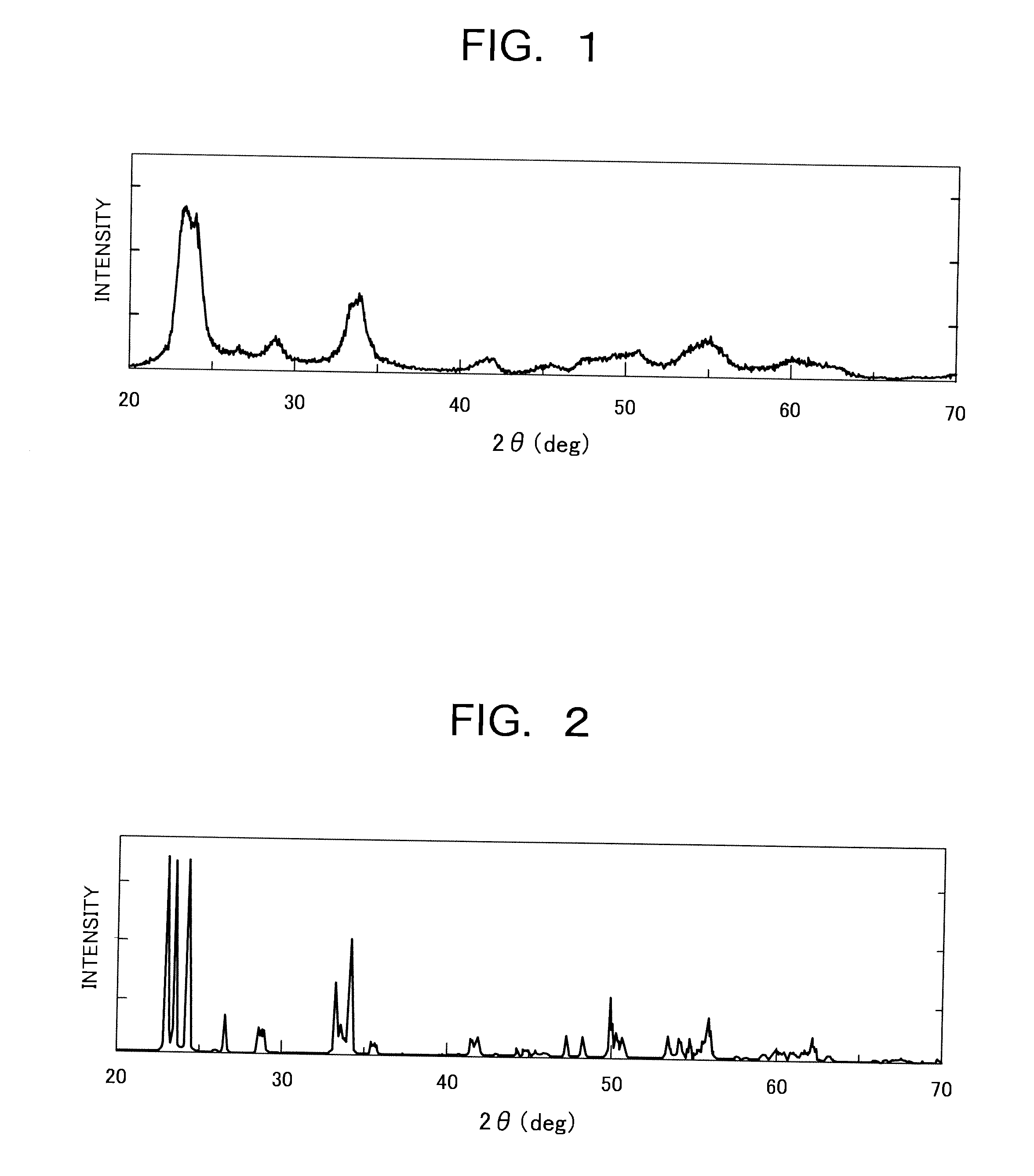Visible-light-responsive photocatalyst powder, and visible-light-responsive photocatalytic material, photocatalytic coating material and photocatalytic product each using the same
a photocatalytic material and visible light technology, applied in the direction of physical/chemical process catalysts, cellulosic plastic layered products, metal/metal-oxide/metal-hydroxide catalysts, etc., can solve the problem that the base material cannot be used for sputter deposition, cannot exhibit sufficient photocatalytic performance in indoor environments, and the process control is complicated, so as to improve and stabilize visible light-exited photocatalytic performance and its reproducibility excellen
- Summary
- Abstract
- Description
- Claims
- Application Information
AI Technical Summary
Benefits of technology
Problems solved by technology
Method used
Image
Examples
example 1
[0076]A tungsten trioxide powder whose average particle size was 0.5 was prepared as a raw material powder. This raw material powder was sprayed to RF plasma together with carrier gas (Ar), and as reaction gas, oxygen was supplied at a flow rate of 75 L / min. A tungsten oxide powder was produced through a sublimation process in which an oxidation reaction of the raw material powder was caused which the raw material powder was being sublimated. The production condition of the powder is shown in Table 1.
[0077]Regarding the obtained tungsten oxide powder, the numerical values of the L*a*b* color system, a BET specific surface area, an average particle size by image analysis of a TEM photo, the nitrogen content, and the content of a metal element were measured. For the L*a*b* measurement, a spectrophotometric colorimeter CM-2500d manufactured by KONICA MINOLTA was used. For measuring the BET specific surface area, a specific surface area measuring instrument Macsorb1201 manufactured by M...
examples 2 , 3
Examples 2, 3
[0084]Tungsten oxide powders were produced through the same sublimation process as that of the example 1 except in that, as reaction gas, argon was supplied at a flow rate of 80 L / min and air was supplied at a flow rate of 5 L / min. In the example 2, the tungsten oxide powder was heat-treated in the atmosphere under the condition of 450°×0.25 h. In the example 3, the tungsten oxide powder was heat-treated in the atmosphere under the condition of 550°×0.5 h. The obtained tungsten oxide powders were subjected to the same measurement and evaluation as those of the example 1. The production conditions of the tungsten oxide powders are shown in Table 1 and the measurement and evaluation results are shown in Table 2. It was confirmed that the tungsten oxide powders of the example 2 and the example 3 both exhibited excellent gas decomposition performance. The X-ray diffraction resulted in a pattern whose peak separation was difficult similarly to that of the example 1.
example 4
[0085]Here, the same sublimation process as that of the example 1 was performed. However, as a raw material injected to plasma, a tungsten oxide powder containing a large amount of impurities such as Fe and Mo was used. The obtained tungsten oxide powder was subjected to the same measurement and evaluation as those of the example 1. The production condition of the tungsten oxide powder is shown in Table 1 and the measurement and evaluation results are shown in Table 2. It was confirmed that the tungsten oxide powder exhibited good gas decomposition performance. From this, it has been confirmed that even containing a trace amount of a metal element as an impurity causes no problem. Incidentally, the X-ray diffraction resulted in a pattern whose peak separation was difficult similarly to that of the example 1.
PUM
| Property | Measurement | Unit |
|---|---|---|
| BET specific surface area | aaaaa | aaaaa |
| particle size | aaaaa | aaaaa |
| 2θ | aaaaa | aaaaa |
Abstract
Description
Claims
Application Information
 Login to View More
Login to View More - R&D
- Intellectual Property
- Life Sciences
- Materials
- Tech Scout
- Unparalleled Data Quality
- Higher Quality Content
- 60% Fewer Hallucinations
Browse by: Latest US Patents, China's latest patents, Technical Efficacy Thesaurus, Application Domain, Technology Topic, Popular Technical Reports.
© 2025 PatSnap. All rights reserved.Legal|Privacy policy|Modern Slavery Act Transparency Statement|Sitemap|About US| Contact US: help@patsnap.com

